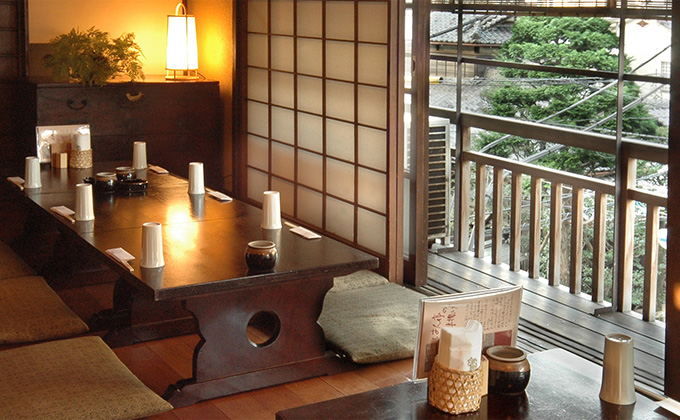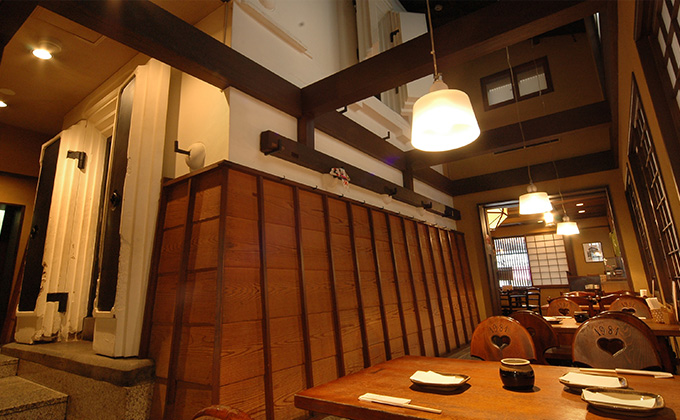Han亭
介绍店铺
体验登录”有形文化財”的建筑
明治時代建造的有价值的建筑物、被日文化厅指定味”登録有形文化財”的Han亭。
经受住关东大地震的3层木造建筑物、像这样的日本家屋在日本国内也不多见。
从二层和三层的日式坐位,可以看得到屋檐瓦砾,感受平民住宅区的气氛。
各种坐位
大多数的坐位是拖鞋后舒适放松的日式坐位、吃饭时感受日式的氛围。
1楼的店内有土蔵、可以边吃边欣赏蔵像的1楼桌面坐位也很有人气。
另外,蔵中也提供7~11位客人使用的日式坐位包房。
还有,4〜5位使用的桌面坐位包房(包房的使用费另外为3000日元)。
可以向店内的服务员到时询问想要的坐位。
Han亭的品尝方法
Han亭的饭菜,是从「一膳」套餐开始的,包括有油炸串6根、小菜2品、生蔬菜。
油炸串的食材由本店来决定,严选当下最美味的食材烹饪。
如果您有不喜欢吃的请直接告诉服务员。
6串油炸串叫做一道”膳”、品尝了每个”膳”之后,我们会征求您的意见,推荐下一道膳(或者3串)。
常备的油炸串共有30多种。根据不同时期,菜单会有变动。
”一膳”和”二膳”中有经典菜和新上市菜、
”三膳”起品尝油炸串的至上味道,最后一道”六膳”基本上品尝到了所有的油炸串!
结账方法
在座位上,或者入口处的收银台都可以。
The History of the Hantei Building
Kushiage Hantei Nezu’s flagship restaurant is housed in an old wooden building. This is the story of a local landmark building in the Nezu area.
The Nezu area, in Chuo-ku, Tokyo, used to be deep inside of the bay when the city of Edo was under the sea. After the seawater dissipated, a river appeared and that river eventually became a road. In the 19th century, merchant houses stood side by side along the street. Later on, a merchant house called Mita Shoten came into existence, which made and sold tsumakawa. Tsumakawa is a kind of flap to cover the tip of geta (traditional Japanese wooden sandals) that protects the wearer’s feet from rain and mud. Tsumakawa were essential at that time because the streets soon became muddy when it rained. Thus, Mita Shoten enjoyed prosperity.
As was typical of a large merchant during those times, Mita Shoten further thrived. In 1909, the building extended its second floor, and in 1917, it added on a third level. The building, built entirely with Japanese zelkova, was beautiful and strong. It endured the strong tremors of the Great Kanto Earthquake in 1923 and also survived World War II.
This wooden structure currently houses Hantei Nezu ’s flagship restaurant, but it took a while for Hantei to acquire the building. After the war, the era of tsumakawa came to an end because of the emergence of western-style shoes, and Mita Shoten had to give up its home. It was handed over to a new company and used as a dormitory. Around that time, the owner of Hantei first noticed this building. Attracted by the beauty of the all-wood structure that had existed for years, the head of Hantei negotiated ownership of the building.
Hantei gained possession of the building a few years later and, as it was in poor condition, set to work restoring it. Carpenters and craft workers felt empathy for the owner, who did not want to change the appearance of the building. He wanted to welcome guests, while maintaining the same impression that he had had when he first encountered the site. Some time later, the building started its new life as Kushiage Hantei and began to draw people’s fascination. Around that time, the name of the building was changed to Hantei. The owner did so with the idea that he would like to take a step forward from this new place.
The Hantei Building, constructed at the beginning of the 20th century, has a 100-year history and is still in use. It was designated as a National Tangible Cultural Property in 1999, and bears a plaque that reads: “A Precious Legacy of the Japanese People.”



